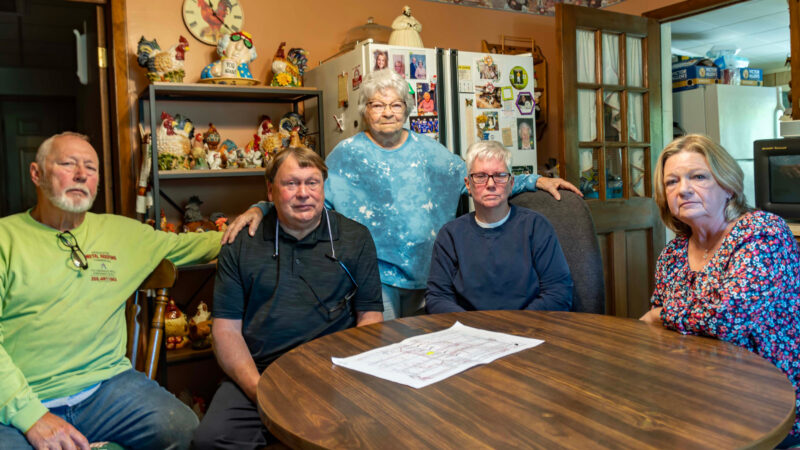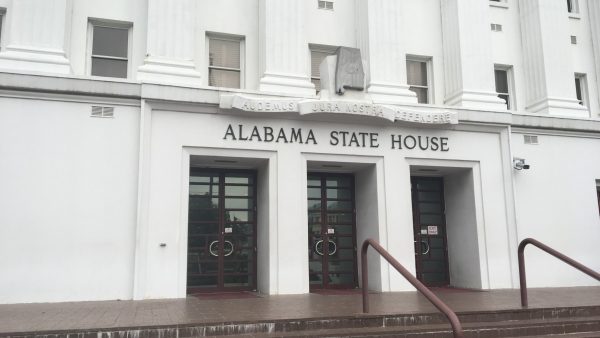The Anniston Depot: All Fired Up
Under the shade of a tent, Army Incinerator spokesperson Mike Abrams described what was happening on a closed circuit video monitor as an M-55 rocket, filled with a gallon of liquid nerve agent — Sarin — made its way down the conveyor belt.
‘What we see is the rocket at the punch station and the top hole about the size of your thumb is a vent. Underneath we will have 2 additional punches come up about the size of your little finger and that is where the agent is drained.’
Drained, but not burned. The Sarin is stored in a thousand gallon tank until the Army has collected a large enough amount to put through another furnace. Meanwhile, Abrams, who’s spent years getting ready for this day, is unable to mask his emotion.
‘This is quite exciting. Here we go! The fuse has just been cut off the end of the rocket, now we’ll see the rocket moved on that television monitor it will move from right to left and we will see a second cut momentarily.’
The rocket is cut into 8 pieces, and moved onto a conveyor belt into a furnace that burns at 1100 degrees.
‘That rocket is now history. This community is one rocket safer.’
There are tens of thousands more to go, but getting started has been the biggest battle in this community.
‘It’s a sad day.’
Rufus Kinney, spokesperson for Families Concerned about Nerve Gas Incineration stood alone by his car with a sign reading ‘Anniston is a human Sacrifice Zone.’ Kinney had fought to legally force the Army to adopt a newer weapons destruction technology here: Neutralization.
‘This community has a right to have that alternative considered for it, just as has happened already in Kentucky, and Colorado, and Maryland, and Indiana. All of which rejected incineration and are now perfectly
happy with neutralization: low temperature, low pressure and no emissions.’
Kinney also doesn’t think the community is prepared for an emergency. Local schools are still working on constructing over-pressurized rooms to be used as shelters. The Army has promised not to burn the liquid nerve agent during school hours, OR to transport weapons during school hours from outdoor igloos where they’re currently stored into the incinerator. Army officials have maintained all along that the weapons pose the greatest danger to the community not in an incinerator, but
sitting in their earthen bunkers. And many here believe them.
‘I’m happy that the beginning of the end has started.’
Keith Howland is one of the closest residents to the incinerator.
‘I mean I would have preferred that our public officials had the presence of mind to demand neutralization a decade ago, but right now if we waited for that, that means we would be held, our whole community would be held under this threat for another 4 to 6 years without any improvement in the probability of being injured.”
The Army estimates it will take 7 years to destroy the Anniston stockpile.
Alabama coal mine keeps digging after hundreds of fines and a fatal explosion
Following the death of a grandfather, Crimson Oak Grove Resources has left a community afraid for their homes and lives. An expert warns one resident may need to evacuate her home while she still can.
Florida’s 6-week abortion ban will have a ‘snowball effect’ on residents across the South
Abortion rights advocates say the ban will likely force many to travel farther for abortion care and endure pregnancy and childbirth against their will.
Attitudes among Alabama lawmakers softening on Medicaid expansion
Alabama is one of ten states which has not expanded Medicaid. Republican leaders have pushed back against the idea for years.
Birmingham is 3rd worst in the Southeast for ozone pollution, new report says
The American Lung Association's "State of the Air" report shows some metro areas in the Gulf States continue to have poor air quality.
Why haven’t Kansas and Alabama — among other holdouts — expanded access to Medicaid?
Only 10 states have not joined the federal program that expands Medicaid to people who are still in the "coverage gap" for health care
Once praised, settlement to help sickened BP oil spill workers leaves most with nearly nothing
Thousands of ordinary people who helped clean up after the 2010 BP oil spill in the Gulf of Mexico say they got sick. A court settlement was supposed to help compensate them, but it hasn’t turned out as expected.







